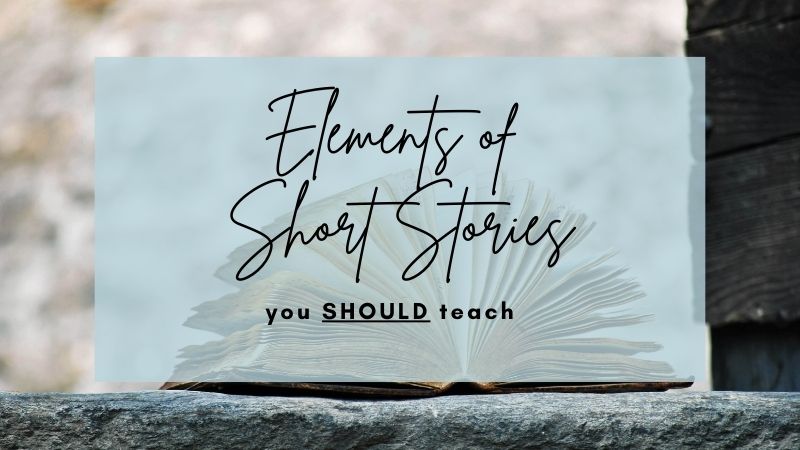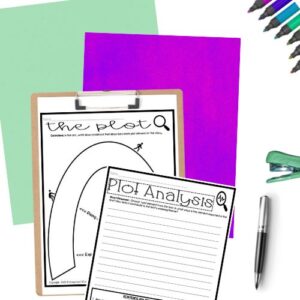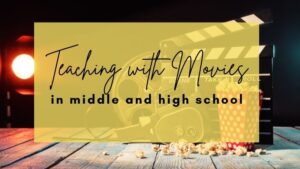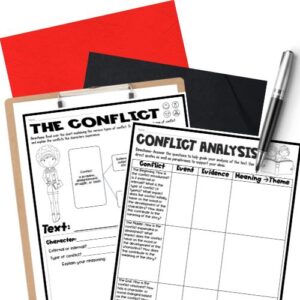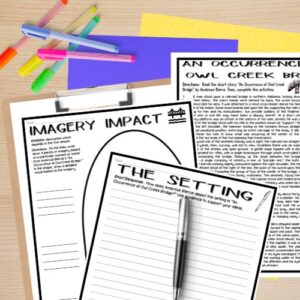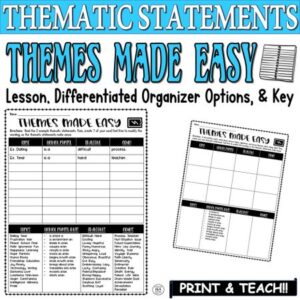I am a huge fan of short stories. And let’s be real, most of our students prefer reading short stories to pretty much anything else. My personal favorites include “The Most Dangerous Game,” “The Tell-Tale Heart,” and “The Lottery,” particularly because they include elements of short stories like developed plots, interesting and compelling conflicts, important themes, well-developed characters, and engaging topics!
Too often, we keep short stories to a unit. I get it. Teaching the elements of short stories within our favorite texts can be appealing. However, I am a bigger fan of teaching thematically. I love to include short stories in larger thematic units that include a novel or play, nonfiction texts, and poetry.
Students learn by making connections, so when we link texts to topics or themes, we are helping them to make connections throughout the year! These units can include a focus on dystopias, mysteries, dramas, comedies, etc.
Keep reading below for “Elements of Short Stories You Should Teach” with helpful tips and activity ideas for each element!
Need help with Test Prep? Check out this FREE Pack of 3 Test Prep Activities to help students achieve success on standardized tests!
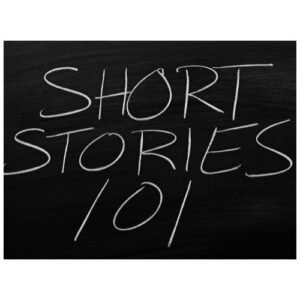
Elements of Short Stories You SHOULD Teach
1. Plot & Basic Elements of Short Stories
A plot is simply a series of events within a story. Don’t make it too complicated. You should definitely start here when teaching Elements of Short Stories!
Now, there are very basic elements of a plot.
- EXPOSITION-the introduction of the setting, characters, and conflict.
- RISING ACTION-the events that develop the conflict and characters, which lead up to the climax.
- CLIMAX-the most important, usually tension-filled event in the story that causes a character and/or characters to change, learn a lesson, experience a theme, etc.
- FALLING the events leading to the resolution of the story.
- RESOLUTION-the end of the story that fills in the gaps for the reader allowing the audience to draw some sort of conclusion about the characters, themes, conflicts, etc.
Have you thought about teaching elements of short stories by using movies? Click here for help!
2. Conflict
The conflict of a story is a problem, disagreement, struggle, or clash. Super simple, right?
There are 2 Major Types of Conflict:
-
External: exists outside of the character
-
Character vs. Character
-
Character vs. Society
-
Character vs. Nature
-
-
Internal: exists within the character
-
Character vs. Self
-
Well, it can be tough to teach conflict, because some conflicts take time to develop within a story. Plus, there could be multiple types of conflict within a single story.
In “The Scarlet Ibis,” we see the conflict involving the two brothers, one of whom resents the other. Only over the course of several pages, do we see the problem the older brother has with the younger brother. By the end of the story, the conflict is resolved, but it is not resolved in the way the protagonist and reader are happy about…
In this story, one could argue that the brother has a conflict with the other brother, so this conflict may be called Character vs. Character. Throughout the story, you can also make the argument that the protagonist is struggling within himself and his feelings toward his brother. If you see the story this way, one can argue that this story uses a Character vs. Self type of conflict.
As long as students use evidence to support their ideas and the ideas make sense when analyzing elements of short stories, then they have identified the conflict(s) correctly!
3. Setting
The setting is the description of the time and place of a story. Authors use settings purposefully. They are most certainly not random.
Let’s look at Edgar Allan Poe’s “The Cask of Amontillado.” The story takes place during the season of carnival in an Italian city. Throughout the story, the characters move from the main city streets down into the deep, dark catacombs.
Clearly, the impact of the setting and the development of the setting within the story has an impact on Fortunato as well as the audience. We can feel death approaching with every step the two characters take. Teaching these two elements of short stories is so important to helping students grow their comprehension skills!
4. Characterization
One of the most significant elements of short stories to teach is characterization. When it comes to characterization, students seem to struggle. They might see what a character does or says at a specific moment, but that may be all. The real questions involving characterization connect to meaning and purpose.
Ex. How do a character’s actions, traits, or speech lead to meaning?
To get to the higher-level questions, we need to go step by step.
- Introduce the definition of “character traits.” Check out this FREEBIE for help!
- Differentiate between internal and external traits.
- Identify what a character says or does.
- Determine what traits a character has based on the evidence.
- Analyze how a character changes or stays the same.
- Examine how the characterization contributes to the meaning or message of the story.
Ultimately, there are 4 types of characters:
- Flat- a character with one or two traits; the character is either good or evil, nice or mean, important or unimportant.
- Round- a character with many traits; the character has a complex personality and makes diverse, more complicated decisions/actions.
The above traits apply to most characters in some way.
- Static- a character that doesn’t change; there are many characters in stories that simply do not change. The audience may learn from the character; however, the character doesn’t develop or learn any lessons.
- Dynamic- a character that does change in some way; the change can be physical, mental, emotional, or spiritual. Usually, there is a resulting action involved.
Ultimately, there should be a character within a story who is dynamic, but sometimes an author will keep a character static so the reader learns an important lesson!
Do you want EASY-TO-TEACH characterization activities for Thank You, Ma’am? Click the link!

5. Mood
All stories depict some sort of mood, and most commonly, the mood changes in some way throughout the story.
The mood is the emotion evoked by the setting, plot, or characters’ actions. It is a feeling that the audience should experience.
Consider “The Tell-Tale Heart” by Edgar Allan Poe. At the start of the story, the reader might feel uncertain because the speaker’s thoughts are so fantastical and seemingly unrealistic. I mean, who is really going to kill an old man because of an odd eye?
Well, the speaker of this story becomes more and more consumed by his dark thoughts, kills the man, and hides his body. With increasing mania, he evokes more and more suspense and horror in the audience.
Recognizing the mood is necessary because it leads to comprehension and analysis of an author’s message/theme.
6. Theme
A theme is a one-sentence message/lesson within a story. Well, I guess you could expand the theme into 2 or 3 sentences, but by requiring only one sentence, your students will be better able to answer the question regarding the theme in a clear, succinct way.
Let’s use “The Pedestrian” by Ray Bradbury as an example for delving into elements of short stories.
At the beginning of the story, we find ourselves involved in the life of Leonard Mead. He is an unassuming man who simply walks every day. Instead of spending his free hours watching television, he ambles outside. Unlike his neighbors, he enjoys the outdoors away from the confines of his house. Ultimately, because he does not conform, he suffers the consequences. “The Pedestrian” personifies the world we live in now, although we are not quite to the point of being sent off to an asylum.

CREATING A THEME BASED ON THE PEDESTRIAN (The Pedestrian Theme)
- MAJOR IDEA: Technology
- TOPIC: Being consumed by technology
- THEME: Consuming too much technology can lead to a superficial life.
I am not saying that the process of coming up with a theme is EASY; however, it can be simple if you use the structure above.
Want a quick and easy way to teach theme while reinforcing elements of short stories? Click to read for ideas HERE!
Other Elements of Short Stories You Might Want To Consider
Once students master the above elements of short stories, you can start introducing other elements like the types of irony, satire, theories of literary analysis, etc. Think of reading a short story in layers.
First, your students must be able to read the story and comprehend basic information. This process takes time as the words, style, syntax, and background knowledge required might be initially tough for students to wade through. Then, after understanding the basic ideas, students may identify the conflict and plot elements. After that, students can focus on mood and how characters develop. Lastly, we get to meaning.
We get to the heart of the text through elements of short stories and why the author wrote it:
- Why did the author write this story?
- What impact does this story have on the audience?
- Why is the story important in studying literature or for society as a whole?
Need more ideas for teaching elements of short stories? Check out my store Kristin Menke-Integrated ELA Test Prep!

